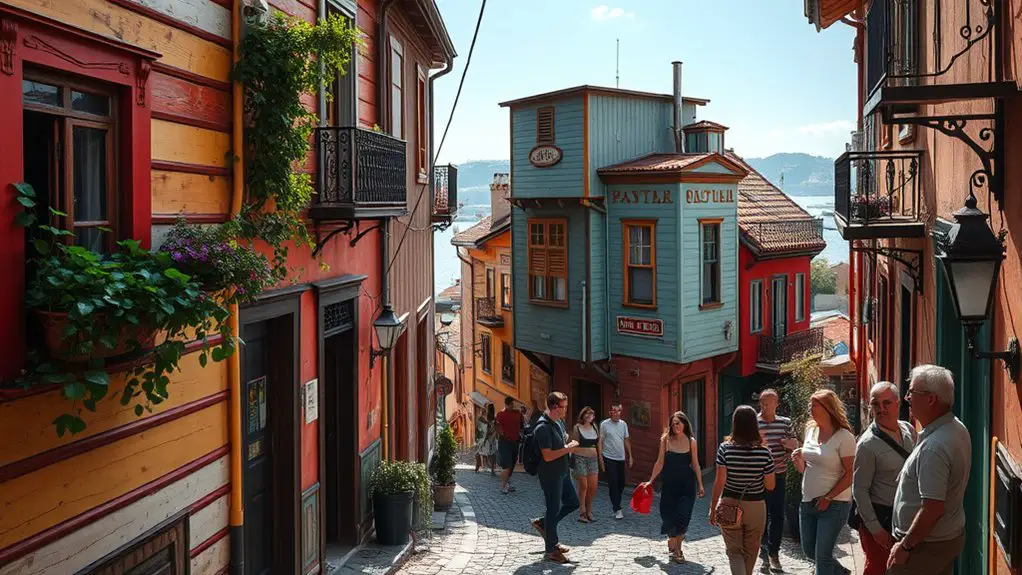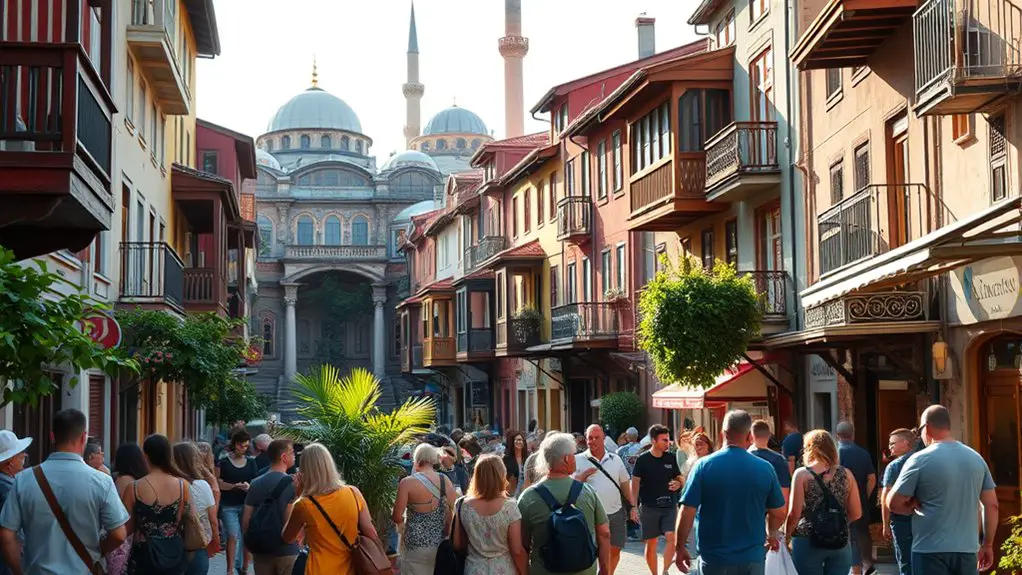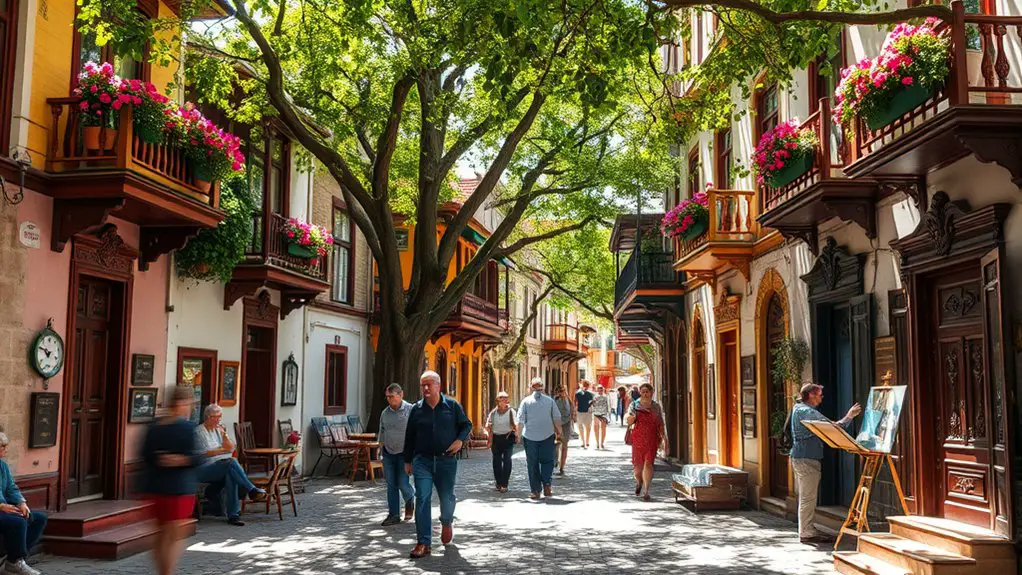Balat’s history reveals a vibrant multicultural hub that dates back to Byzantine times when it was a small fishing village along the Golden Horn. Over centuries, it evolved through diverse influences, including Christian, Jewish, and Muslim communities, reflected in its religious sites and architecture. Ottoman additions further shaped its urban landscape, blending traditional and modern styles. Tourists can explore its key landmarks to better understand its rich and complex past, with much more to discover as you continue exploring.
Key Takeaways
- Balat originated as a Byzantine fishing village and developed into a diverse trade hub along the Golden Horn.
- Its cultural mosaic includes Jewish, Christian, and Muslim communities, reflected in religious sites and local traditions.
- Architectural styles in Balat span Byzantine, Gothic, Ottoman, and modern influences, showcasing its layered history.
- Key historical sites like the Balat Synagogue, Chora Church, and Fener Greek Orthodox Patriarchate reveal its multicultural past.
- The neighborhood has evolved through Ottoman rule, modern urban changes, and ongoing preservation of its rich cultural heritage.
The Origins and Early Settlements of Balat

Balat’s origins trace back to Byzantine times, when it was established as a small fishing village along the Golden Horn. Its strategic location made it an important hub for early trade routes connecting inland Anatolia with the maritime trade network of Constantinople.
Balat originated in Byzantine times as a key fishing village along the Golden Horn, linked to vital trade routes.
As a fishing village, it supplied local markets with seafood, supporting both residents and traders passing through the area. The proximity to major trade routes facilitated economic activity, attracting artisans and merchants who contributed to the neighborhood’s growth.
Early settlements consisted of modest structures built close to the water, reflecting the community’s dependence on fishing and trade. Over time, Balat’s role as a trading point strengthened, laying the foundation for its diverse cultural fabric.
Its development was shaped by its geographical advantage, which provided access to maritime commerce, and its early inhabitants’ reliance on fishing and trade as primary economic activities.
Cultural Diversity and Religious Heritage

Despite its small size, Balat has long been a melting pot of cultures and religions, shaped by its historical position as a crossroads of trade and migration. This unique setting fosters diverse cultural influences, evident in local traditions, cuisine, and craftsmanship.
The neighborhood’s religious coexistence is particularly notable, with Jewish, Christian, and Muslim communities living side by side for centuries. Synagogues, churches, and mosques punctuate the landscape, reflecting a history of tolerance and shared identity. These religious structures not only serve spiritual purposes but also stand as symbols of intercultural harmony.
The area’s cultural influences are further reflected in its vibrant markets, colorful houses, and communal celebrations that blend various traditions. This intricate tapestry of religious heritage and cultural diversity contributes to Balat’s distinctive character, making it a living representation of coexistence amid historical complexity.
Understanding this heritage enhances your appreciation of Balat’s enduring legacy.
Architectural Evolution Through the Centuries

The architectural landscape of Balat reflects a dynamic evolution shaped by centuries of social, cultural, and political changes. You’ll notice this progression through several key features:
- Byzantine remnants, such as surviving churches and mosaics, highlight early Christian influences and the region’s religious significance.
- Gothic influences become evident in some structural elements, like pointed arches and decorative stonework, indicating the impact of Western European styles.
- The layered construction of residential buildings reveals adaptations over time, with Ottoman-era additions blending seamlessly into earlier Byzantine foundations.
- Narrow, winding streets and densely packed facades illustrate urban development influenced by various periods, emphasizing both practicality and aesthetic shifts.
This evolution showcases a blend of architectural styles that reflect Balat’s diverse history.
The coexistence of Gothic and Byzantine elements underscores the area’s role as a cultural crossroads, demonstrating how different eras and influences have shaped its unique visual identity.
Balat During the Ottoman Empire and Modern Times
Following the layered architectural developments of earlier periods, Balat entered a transformative phase during the Ottoman Empire that profoundly influenced its social fabric and urban landscape. Under Ottoman governance, the neighborhood became a diverse hub, with Jewish, Greek, and Armenian communities shaping its character. The period saw the construction of religious and communal buildings, reflecting the multicultural fabric. Modern influences began to merge in the late 19th and early 20th centuries, introducing new styles and infrastructure, yet balancing tradition. This era marked a shift from purely Ottoman-era structures to a blend of historical and modern architecture. The neighborhood’s social dynamics evolved, influenced by migration, economic changes, and urban policies. Today, Balat retains a layered identity rooted in its Ottoman past while integrating modern elements, making it a living mosaic of history and contemporary life. Its evolution highlights a complex interplay between governance, cultural diversity, and modernization efforts over centuries.
| Aspect | Details |
|---|---|
| Ottoman governance | Influenced architecture and social diversity |
| Religious buildings | Synagogues, churches, mosques shaping urban landscape |
| Cultural diversity | Jewish, Greek, Armenian communities coexisted |
| Modern influences | 19th-century styles, infrastructure developments |
| Urban transformation | Blend of historical and modern architectural elements |
Key Historical Sites and Places to Explore
Balat is home to a rich array of historical sites that exemplify its layered past and cultural diversity. Exploring its neighborhoods reveals a tapestry of historical landmarks that reflect different eras.
First, the Balat Synagogue stands out as a symbol of the area’s Jewish heritage, showcasing architectural features from the Byzantine period.
Second, the Chora Church, with its intricate mosaics and frescoes, highlights Byzantine religious artistry.
Third, the Fener Greek Orthodox Patriarchate offers insights into the Christian community’s historical presence.
Fourth, the Balat Mosque exemplifies Ottoman-era Islamic architecture, emphasizing religious harmony.
These sites, scattered across the various Balat neighborhoods, reveal the neighborhood’s multifaceted history. Each landmark contributes to an understanding of the cultural and religious influences that shaped Balat.
Visiting these historical landmarks provides an all-encompassing view of the area’s diverse past and its significance as a melting pot of cultures over centuries.
Frequently Asked Questions
How Has Balat’s Demographic Composition Changed in Recent Decades?
You’ll notice Balat’s demographic shifts due to gentrification trends, attracting more affluent residents, while immigrant populations, especially Jewish and Greek communities, have decreased, leading to a more diverse but changing cultural landscape over recent decades.
Are There Any Local Legends or Folklore Associated With Balat?
You’ll find Balat legends and Balat folklore deeply woven into the district’s culture, revealing stories of resilience, mystery, and spirituality that reflect its diverse history, making them fascinating elements for visitors seeking an authentic, analytical experience.
What Are the Traditional Cuisines Unique to Balat’s Communities?
You explore Balat’s vibrant streets and taste traditional recipes that reflect its layered history, revealing culinary influences from Greek, Jewish, and Turkish communities, creating a rich tapestry of flavors that embody the neighborhood’s diverse cultural heritage.
How Does Balat’s History Influence Its Current Urban Development?
Balat’s history shapes its urban renewal efforts by prioritizing cultural preservation, blending historic architecture with modern development, which maintains its unique identity while fostering sustainable growth, ensuring that revitalization respects its rich cultural and historical roots.
Are There Annual Festivals or Events Celebrating Balat’s Heritage?
They say “every city has its festivals,” and Balat’s cultural celebrations and heritage events occur annually, highlighting its diverse history. These events foster community pride, attract tourists, and preserve the neighborhood’s rich, layered cultural identity effectively.
Conclusion
Exploring Balat uncovers a layered tapestry of history, where each brick and alley reflects centuries of cultural exchange and resilience. Its rich heritage acts as a mirror, revealing the city’s evolving identity amidst shifting empires and modern influences. By understanding Balat’s past, you gain insight into its enduring spirit—a living mosaic that continues to shape its vibrant present. This neighborhood stands as a proof of history’s enduring power, inviting you to witness its story firsthand.
